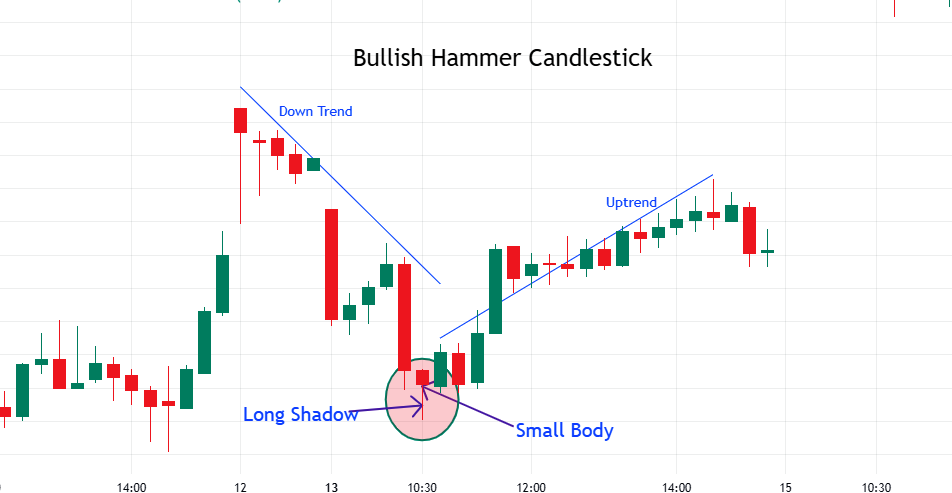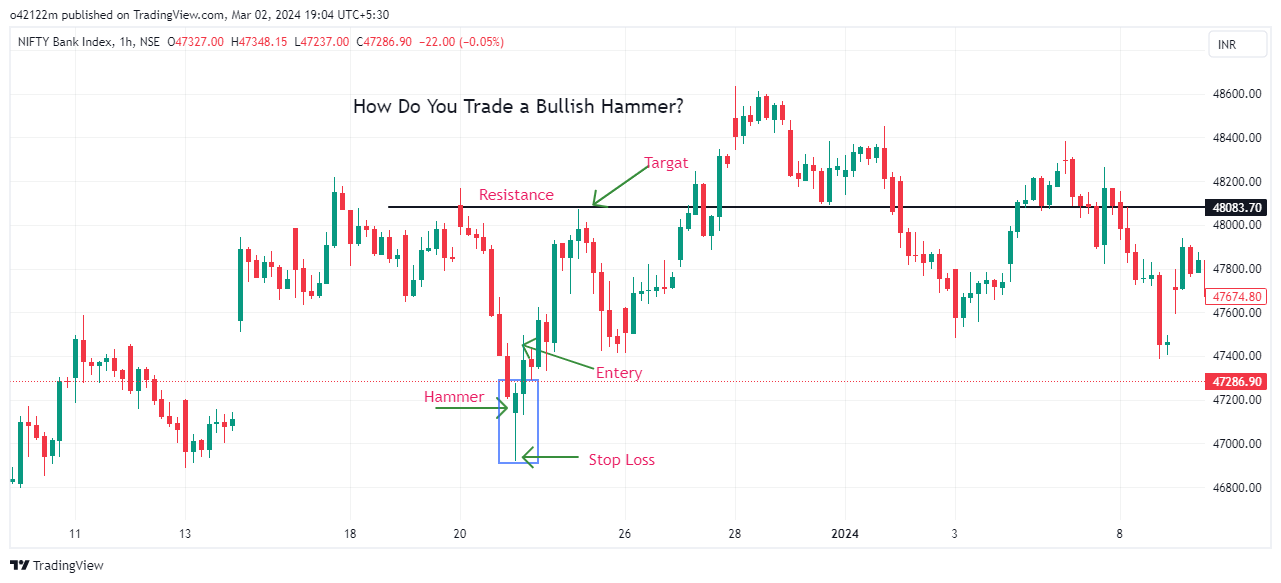Introduction
Hey everyone! Imagine you’re in a super cool world of trading. Learning about something called “candlestick patterns” is like having a special skill for success. One of these patterns is the “bullish hammer,” which is like a super powerful signal. It tells traders that the trend might flip, and there’s a chance to make some money. This article is like your guidebook to the bullish hammer candlestick. We’ll talk about what it is and how often it works, show you real examples, and give you the scoop on how to trade it and what risks and rewards are involved. Let’s jump into the adventure!
What is a bullish hammer candlestick?

Sure thing! A bullish hammer is like a special signal in trading, and it’s easy to spot. Picture a candlestick that looks like a tiny hammer. It has a short body, a long lower part (like the hammer’s handle), and almost no upper part. This candlestick shows up after prices have been going down for a bit. It tells us that even though the bears (the sellers) tried to make prices go lower, they couldn’t succeed. This little hammer suggests that the market mood might be about to change, and things could start going up. Cool, right?
An example of a bullish hammer?
Let’s imagine a situation with a stock that’s been on a bit of a downslide, consistently hitting lower lows. Out of the blue, a bullish hammer shows up, giving a hint that the sellers might be getting tired. Now, if more people are trading and feeling positive about the market at the same time, that’s like a strong example of a bullish hammer doing its thing. It’s kind of like the stock saying, “Hey, maybe it’s time for a change!”
What Happens After a Bullish Hammer?
When you see a bullish hammer, it’s like a hint that the market might be turning positive. Traders see it as a sign that the buyers are taking charge, and things might start going up. But here’s the catch: it’s super important to check out other signs and what’s happening in the market to make sure this positive change is for real. Always good to double-check!
What is the success rate of the bullish hammer in trading?
So, how often does the bullish hammer work? Well, it’s pretty dependable, but its success rate isn’t set in stone. The trick is to team it up with other tools for a more accurate picture. Smart traders don’t just rely on the bullish hammer alone; they bring in friends like trendlines, support and resistance levels, or other candlestick patterns to understand what’s going on in the market. Teamwork makes the dream work!
How Do You Trade a Bullish Hammer?

Let’s dive a bit deeper into how to trade a bullish hammer. Imagine you’re in the trading game, and you spot this bullish hammer pattern. Now, to make a move:
- Confirmation is key. Patience is your buddy here. Don’t jump the gun. Wait for confirmation that the market is indeed changing direction. Some traders look for the next candlestick to close higher than the bullish hammer’s high.
- Getting In If things look positive after confirmation, some traders enter a “long position.” That just means they’re betting the price will go up. They usually do this by buying shares or contracts above the highest point of the bullish hammer.
- Safety Net with Stop-Loss: Trading always involves some risk, and smart traders use a safety net. In this case, it’s the “stop-loss order.” It’s like setting a limit on how much you’re willing to lose. Traders often put their stop-loss orders just below the lowest point of the bullish hammer.
- Keep an Eye on the Big Picture: Trading isn’t just about one thing. It’s like putting together a puzzle. So, while the bullish hammer is cool, it’s even better when you look at the whole picture. Check out other signs in the market, like trendlines or support and resistance levels. They’re like your backup team, helping you make smarter moves.
Remember, it’s not just about spotting the bullish hammer but using it wisely alongside other tools to make your trading game strong. Happy trading!
What is the risk-reward of a bullish hammer?
Alright, let’s break down the risks and rewards of dealing with a bullish hammer in a down-to-earth way.
Risk and Reward: What’s the Deal?
When you’re in the trading game, you’ve got to balance the risk and reward. Think of it like a seesaw: you want one side (the reward) to be heavier than the other (the risk). Now, with a bullish hammer, how much risk you take on and how much reward you aim for depends on your comfort with risk and what’s going on in the market.
Finding the Right Balance:
Smart traders always aim for a good balance, where the potential gains are worth more than the possible losses. This is what they call the “risk-reward ratio.” It’s like making sure that if things go well, you’re going to make more than you could lose.
Putting It All Together:
In a nutshell, getting the hang of the bullish hammer is like having a superpower for traders wanting to make the most of trend changes. But it’s not just about spotting it; it’s about being smart with it. You combine your technical analysis skills, what you know about the market, and how you manage risks. It’s like putting all the pieces together to make sharp and wise decisions in the exciting world of financial markets. Happy trading!
Conclusion:
Mastering the intricacies of the bullish hammer candlestick pattern is a valuable asset for any trader navigating the complex world of financial markets. As a reliable indicator of potential trend reversals, the bullish hammer provides a glimpse into shifting market sentiments. However, it is crucial to exercise caution and complement this pattern with other technical analysis tools for a comprehensive understanding of market dynamics. Successful trading involves a judicious combination of the bullish hammer pattern, risk management strategies, and a keen awareness of market conditions.
Click here and read the related article in detail
The Mystery of Hammer Candlestick Patterns and Their Variations
FAQs:
Q1: Can a bullish hammer pattern occur in any market?
Yes, the bullish hammer candlestick pattern can occur in various financial markets, including stocks, forex, and commodities. Its applicability extends to different timeframes, providing traders with a versatile tool for analysis.
Q2: How long should one wait for confirmation after spotting a bullish hammer?
The waiting period for confirmation can vary, but many traders prefer to wait for the next candle to close above the high of the bullish hammer for a more reliable signal. Additionally, considering other technical indicators and market conditions aids in confirming the potential reversal.
Q3: Are there other candlestick patterns that work well with the bullish hammer?
Yes, traders often combine the bullish hammer with other candlestick patterns, such as engulfing patterns or doji candles, for a more robust analysis. It is advisable to integrate multiple signals to enhance the accuracy of predictions.
Q4: What risk management strategies are recommended when trading a bullish hammer?
Implementing a stop-loss order below the low of the bullish hammer is a common risk management strategy. This helps limit potential losses in case the anticipated reversal does not materialize. Traders should also consider their risk tolerance and adjust position sizes accordingly.
Q5: Can the bullish hammer pattern be used in isolation for trading decisions?
“While the bullish hammer serves as a potent indicator, it is prudent to employ it in tandem with additional technical analysis tools and market expertise. Depending solely on one pattern may result in less-than-optimal trading decisions. The amalgamation of signals contributes to bolstering the overall efficacy of a trading strategy.”

1 thought on “What is a Bullish Hammer Candlestick?”